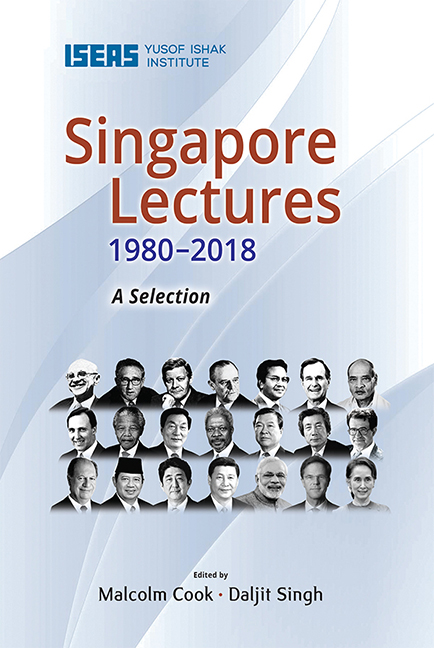Book contents
- Frontmatter
- Contents
- Introduction
- 1 The Invisible Hand in Economics and Politics
- 2 American Foreign Policy: A Global View
- 3 The Soviet Union: Challenges and Responses as Seen from the European Point of View
- 4 Trends in the International Financial System
- 5 Regionalism, Globalism and Spheres of Influence: ASEAN and the Challenge of Change into the 21st Century
- 6 US Policy in the Asia-Pacific Region: Meeting the Challenges of the Post-Cold War Era
- 7 India and the Asia-Pacific: Forging a New Relationship
- 8 Australia, Asia and the New Regionalism
- 9 South and Southern Africa into the Next Century
- 10 China and Asia in the New Century
- 11 Global Values: The United Nations and the Rule of Law in the 21st Century
- 12 Peace on the Korean Peninsula and East Asia
- 13 Japan and ASEAN in East Asia: A Sincere and Open Partnership
- 14 EU and Asia: Sharing Diversity in an Inter-regional Partnership
- 15 Global Challenges in the 21st Century: A View from Chile
- 16 Indonesia: The Challenge of Change
- 17 Japan and ASEAN, Always in Tandem: Towards a More Advantageous Win-Win Relationship through My “Three Arrows”
- 18 Forging a Strong Partnership to Enhance Prosperity of Asia
- 19 India’s Singapore Story
- 20 The Netherlands, Singapore, Our Regions, Our World: Connecting Our Common Future
- 21 Democratic Transition in Myanmar: Challenges and the Way Forward
- The Singapore Lecture Series
- The Editors
6 - US Policy in the Asia-Pacific Region: Meeting the Challenges of the Post-Cold War Era
Published online by Cambridge University Press: 09 October 2021
- Frontmatter
- Contents
- Introduction
- 1 The Invisible Hand in Economics and Politics
- 2 American Foreign Policy: A Global View
- 3 The Soviet Union: Challenges and Responses as Seen from the European Point of View
- 4 Trends in the International Financial System
- 5 Regionalism, Globalism and Spheres of Influence: ASEAN and the Challenge of Change into the 21st Century
- 6 US Policy in the Asia-Pacific Region: Meeting the Challenges of the Post-Cold War Era
- 7 India and the Asia-Pacific: Forging a New Relationship
- 8 Australia, Asia and the New Regionalism
- 9 South and Southern Africa into the Next Century
- 10 China and Asia in the New Century
- 11 Global Values: The United Nations and the Rule of Law in the 21st Century
- 12 Peace on the Korean Peninsula and East Asia
- 13 Japan and ASEAN in East Asia: A Sincere and Open Partnership
- 14 EU and Asia: Sharing Diversity in an Inter-regional Partnership
- 15 Global Challenges in the 21st Century: A View from Chile
- 16 Indonesia: The Challenge of Change
- 17 Japan and ASEAN, Always in Tandem: Towards a More Advantageous Win-Win Relationship through My “Three Arrows”
- 18 Forging a Strong Partnership to Enhance Prosperity of Asia
- 19 India’s Singapore Story
- 20 The Netherlands, Singapore, Our Regions, Our World: Connecting Our Common Future
- 21 Democratic Transition in Myanmar: Challenges and the Way Forward
- The Singapore Lecture Series
- The Editors
Summary
On 4 January 1992, President of the United States of America George H.W. Bush gave the 12th Singapore Lecture after being welcomed by Senior Minister Lee Kuan Yew. President Bush was the first and still the only US President to give a Singapore Lecture. His lecture focuses on the profound global strategic changes ushered in by the end of the Cold War, and for US engagement in East Asia and with ASEAN. In the current period of doubt over the US interests and influence in East Asia, this lecture serves as a useful, recent counterpoint
Thank you, Mr Minister. Prime Minister Goh and Senior Minister Lee, I am delighted to be here and thank you for that very kind introduction. Let me take this opportunity to say a few words about these two gentlemen.
Minister Lee, a quarter century ago, you led this small island of cultural and ethnic diversity, of limited physical resources, to independence. Then, through your vision and your force of intellect and will, you forged Singapore's nationhood. You stood courageously in a life and death struggle against the communists, and you prevailed. You led your nation and your region in the quest for peace and prosperity. It is my convinced opinion that future generations will honour the name of Lee Kuan Yew. And as you know well from your visits to my home in Kennebunkport, I am pleased to know you as a friend.
Prime Minister Goh, I salute you for your wisdom and your vigour in carrying Singapore forward on its path to the future. I pledge America's steadfast friendship as you lead Singapore in facing the challenges of the coming generation. I am also pleased that you, like many of your countrymen, came to the United States of America for part of your education. These, too, are ties that bind us together.
It is an honour to deliver this lecture, following such leaders as Brian Mulroney, Helmut Schmidt, Rudd Lubbers, Bob Hawke, Mahathir bin Mohamad, and Valery Giscard D’Estaing and such distinguished thinkers as Henry Kissinger and Milton Friedman. And, let me acknowledge: Professor K.S. Sandhu, Director of the Institute of Southeast Asian Studies; A.V. Liventals, Chairman, Mobil Oil Singapore; Lee Hee Seng, Deputy Chairman, ISEAS Board of Trustees; and Dr Richard Hu, Chairman, Monetary Authority of Singapore, and Finance Minister.
- Type
- Chapter
- Information
- Singapore Lectures 1980-2018 , pp. 97 - 106Publisher: ISEAS–Yusof Ishak InstitutePrint publication year: 2020

